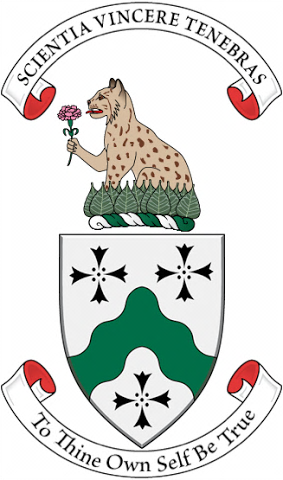Steven A. Harris
| Heraldry of the World Personal arms |
STEVEN A. HARRIS
Registration no.: 005/2017
Individual/family : Individual
Country of origin : United States
Place of origin : Greendale, Massachusetts
Granted : No
Granted/officially recorded by : -
Official English blazon
Arms: Argent a chevron wavy Vert between three crosses erminée Sable Crest: Vert doubled Argent; from a wreath of sacred fig leaves a bobcat sejant holding aloft in her dexter paw a pink carnation, all proper Motto: (below the shield) To Thine Own Self Be True (above the crest) Scientiā Vincere Tenebrās - Latin: conquering darkness by science
Other language blazon
Origin/meaning
Arms
The silver (Argent) of the shield, often illustrated as white or gray, represents selflessness and a desire for practical simplicity, especially when weighed against the other heraldic metal, gold. Being in the middle of the spectrum, the color green (Vert) represents equality and tolerance, a rejection of extremism, an open-minded and non-judgmental acceptance of different lifestyles and beliefs, which stands in opposition to hateful bigotry and repressive convictions. Although not specified in the blazon, the specific shade of green used (sometimes called ‘watercourse green’, #006E48) was the corporate color of my first employer.
The chevron principal charge is taken from the arms of the Virginia Military Institute (VMI), where I studied Chemistry and English literature. On the arms of VMI, the broken chevron serves as an augmentation of honor for the ten cadets who fell at the Battle of New Market on 15 May 1864, under the command of Confederate Major-General John C. Breckinridge, previously Vice-President of the United States (1857- 1861). Moreover, the chevron commemorates the long tradition of military service in my family, tracing back to the American Revolutionary War. The wavy lines of the chevron answer the bend wavy on the arms assumed by my father in January 1999 (American College of Heraldry registration #1749 - I disclaimed my father’s arms on 3 March 2008). Each cross, recalling the Roman Catholic faith of my upbringing, is composed of four ermine spots – a heraldic symbol of nobility – representing my four children. Taken all together, the three crosses represent my three daughters and the chevron represents my son. The four ermine tails in each cross also evoke the four cardinal virtues (ἀρετή) as derived 25-centuries ago by the Greek sophist Protagóras: prudence (φρόνησις), justice (δικαιοσύνη), temperance (σωφροσύνη), and fortitude (ἀνδρεία).
Additionally, it is worth observing that the chevron-between-three-charges design, the sable-on-argent theme, and the ermine family of furs are all common elements in arms used by those surnamed Harris (The General Armory of England, Scotland, Ireland and Wales. Sir Bernard Burke, Ulster. London, 1884. pp 459-460).
Crest
Atop the helm sits a wreath of leaves from the sacred fig tree (Ficus religiosa), under which Siddhārtha Gautama was awakened and attained enlightenment as Buddha. Additionally, the wreath of leaves alludes to my given name, Steven, which originated from the Ancient Greek name Στέφανος, meaning “crowned with a wreath”.
Rising out of the wreath is a bobcat or red lynx (Lynx rufus), which has served as a symbol for the learned sciences since the spark of the modern scientific revolution in 1543. In Greek, Norse, and Native American mythologies, the elusive and mysterious lynx held the ability to see through falsehood and to unravel hidden truths. In Arthurian legends, a red lynx has been attributed to Sir Lucan, Chamberlain of Camelot and King Arthur’s most-learned knight.
Reminiscent of the Buddha’s Flower Sermon, the lynx (which Pliny the Elder had named a “chama” in his Nātūrālis Historia) holds aloft a single blossom. The carnation (Dianthus caryophyllus) is both January’s birth-flower and the state flower of Ohio – corresponding to when and where I was born. The carnation is pink since the supplementary color of ‘watercourse green’ is called ‘carnation pink’, #FF91B7. The flower also suggests a calm mindfulness and a contemplative temperament.
Motto and Slogan
On a scroll below the shield is an English motto: “To Thine Own Self Be True”, as spoken by Polonius to his son Laërtes in Shakespeare’s tragedy Hamlet (Act I, scene 3). On a scroll above the crest is a Scottish-style slogan: the Latin phrase « Scientiā Vincere Tenebrās », which may be translated as “conquering darkness by science”.
Badge An octagon Sable charged with three annulets interlaced two over one within an orle Argent
Plant Badge
pink carnation
Registration details
International Association of Amateur Heralds, as Fellow (10 June 2015), formerly as Associate Fellow (5 April 2009), Member (9 February 2008)
American Heraldry Society, as Member (30 July 2008)
International Heraldry Society, as Member (9 September 2008)
Heraldry Society of Scotland, as Member (22 April 2011)
Royal Heraldry Society of Canada, as Member (13 August 2011)
United States Heraldic Registry (17 August 2011)
New England Historic Genealogy Society (17 March 2012)
Associated Clan MacLeod Societies, sealed by the MacLeod of MacLeod (28 June 2012)
International Society of Commoners Heraldry (20 October 2016)
Contact and Support
Partners:
Your logo here ?
Contact us
© since 1995, Heraldry of the World, Ralf Hartemink
Index of the site

